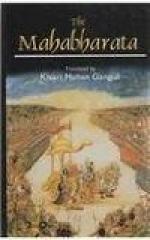608. The Bengal reading mrishtascha varina is incorrect. The Bombay reading mrishtasya varinsha is correct.
609. The word—kavi used in this verse, means Agni or fire, as explained by the commentator, One of the vernacular translators wrongly takes it as implying the preceptor Sukara.
610. The last verse, as read in the Bengal texts, is vicious. Nastyandam astitu Brahma, etc., is the correct reading.
611. To an afflicted person the day seems long.
612. The sense is that it is this Kesava who upholds the cause of Righteousness when dangers overtake it. cf. ’Yada yada hi dharmasya, etc.’ in the Gita. It does not mean that when doubts are entertained by persons on questions of morality, it is Kesava who dispels them.
613. Refers to the existence of Brahma when all else is nought.
614. The fivefold seed consists of the four orders of creatures and acts which determine the conditions of all beings.
615. Eagle marmelos, Linn.
616. Durvasa is regarded as a portion of Mahadeva. The question of Yudhishthira, therefore, really relates to Mahadeva although the name that occurs is of Durvasa.
617. A Parvam is a knot. Reeds and bamboos consist of a series of knots. The space between two knots is called a Salya.
618. The allusion is to the fiery mare’s head which is supposed to wander through the ocean.
619. Verses 4 to 9 are extremely difficult. They represent so many surceases. Nilakantha, however, has shown great ingenuity in expounding them. In the first line of 4, drishtam refers to pratyaksham, and srutam to sruti or agama. Hence, what is meant by the first line is,—Innumerable are the cases of both direct perception and scriptural assertion in which the scriptures are regarded as more authoritative, and those is which direct perception is regarded as more authoritative. In 5, the speaker refers to the atomic and other theories of the creation derived from Reason. Bhishma declares it as his opinion that all such theories are untenable or groundless. In the first line of 6, the word Ekam implies Brahma. The sense is, if thou thinkest that Brahma alone is the cause of the universe and in thinking so becomest landed on doubt. The reply to this is that Yoga for a long course of years will enable thee to comprehend the sufficiency of unassisted Brahma to evolve the universe. In 7, anekam pranayatram kalpamanena refers to one who without leading any particular or settled mode of life lives just as it suits him to live, that is, who leads the life of a religious mendicant never thinking of the morrow. In 9, anihaddham vacha implies what is not defined or indicated by the words of the Vedas or scriptures. The Burdwan Pundits have made a mess of the whole passage, or, rather, of nearly the whole of this section.
620. Teshu is equivalent to praryakshanumanachareshu. The sense, therefore, is that the three, viz., direct perception, inference, and good conduct being, for these reasons, fallible, the only infallible standard that remain, is audition or the scriptures, or, as verse 14 puts it, men with understandings born of the scriptures.




